Author: Editor
Noopura Bhramari in collaboration with Kalagowri had organized a State level Dance Research Symposium on the occasion of its completion of tenth year on the day of Mahashivarathri by way of Shivaaraadhana through Nrithyaadhyayana at Basavanagudi, Bengaluru.
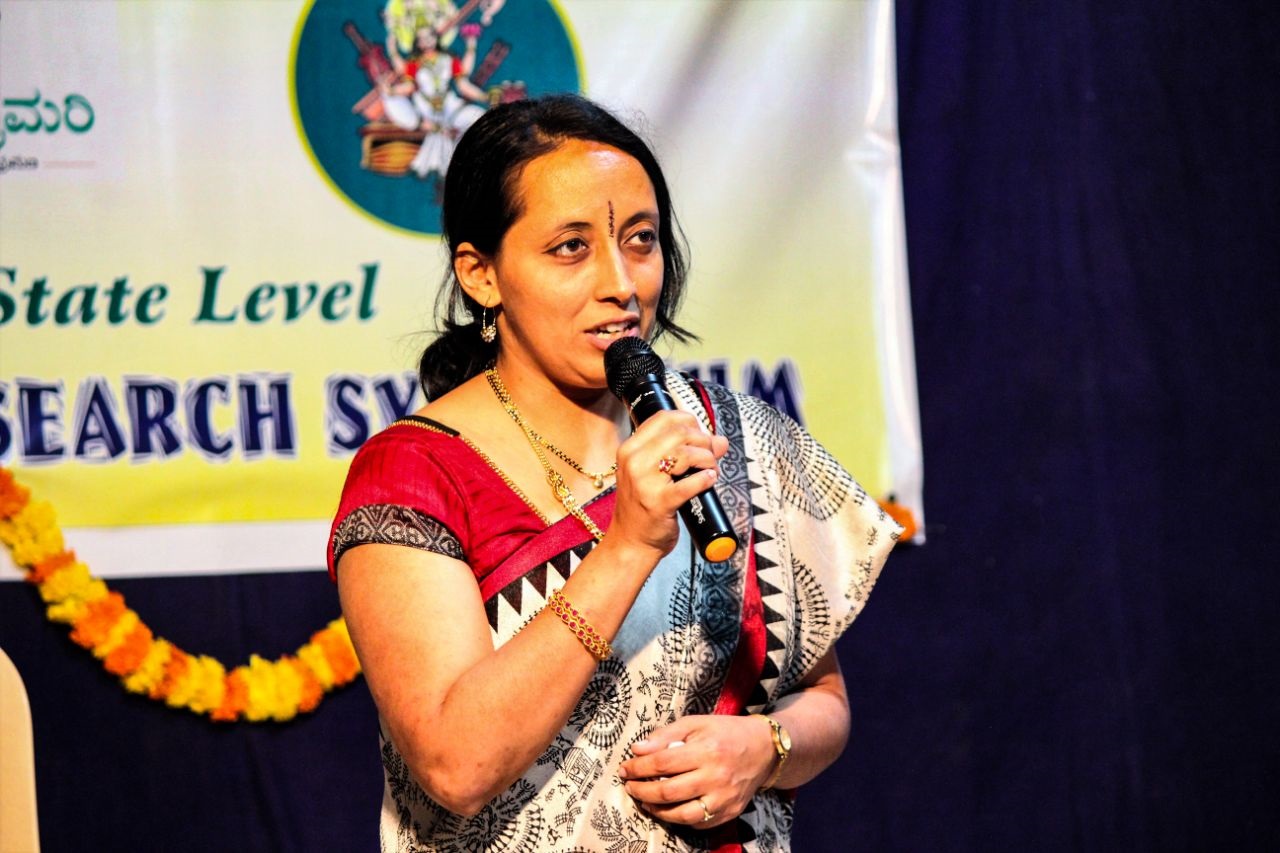
On the day of Symposium- The morning session started with obeisance to the Lord Nataraja and the Anklets by all the members of Noopura Bhramari and Kalagowri. Every one of them performed a special Pooja by way of prayers, vedic chants, offerings of flowers and fruits and finally the arathi. In the afternoon, the research symposium session started with a prayer by Smt. Megha Srinivas and welcome speech by Dr. Manorama. B.N.
The first paper presentation in the research symposium titled ‘Theorizing the practicality’, started with ‘Tracing the Adavu through the study of treatises in Sanskrit’ by Smt. Anupama Jayasimha. The second paper was presented by Ranjana Nagaraja on ‘Symbolic representation of Hastas and Adavus of Bharatanatyam’ (along with practical demo). The next paper was on ‘Role of Nayaka in Nayika composition’ (along with research based dance item) by Smt. Madhulika Srivatsa. Smt. Deeptishri Bhat presented a paper on ‘Classification, duties of Sakhi and her representation in dance and dramas (along with research based dance item). There was a Panel discussion followed by demonstration by Smt. Divya Shivnarayan on the subject of ‘Alaripu – Practicality and Newness’.
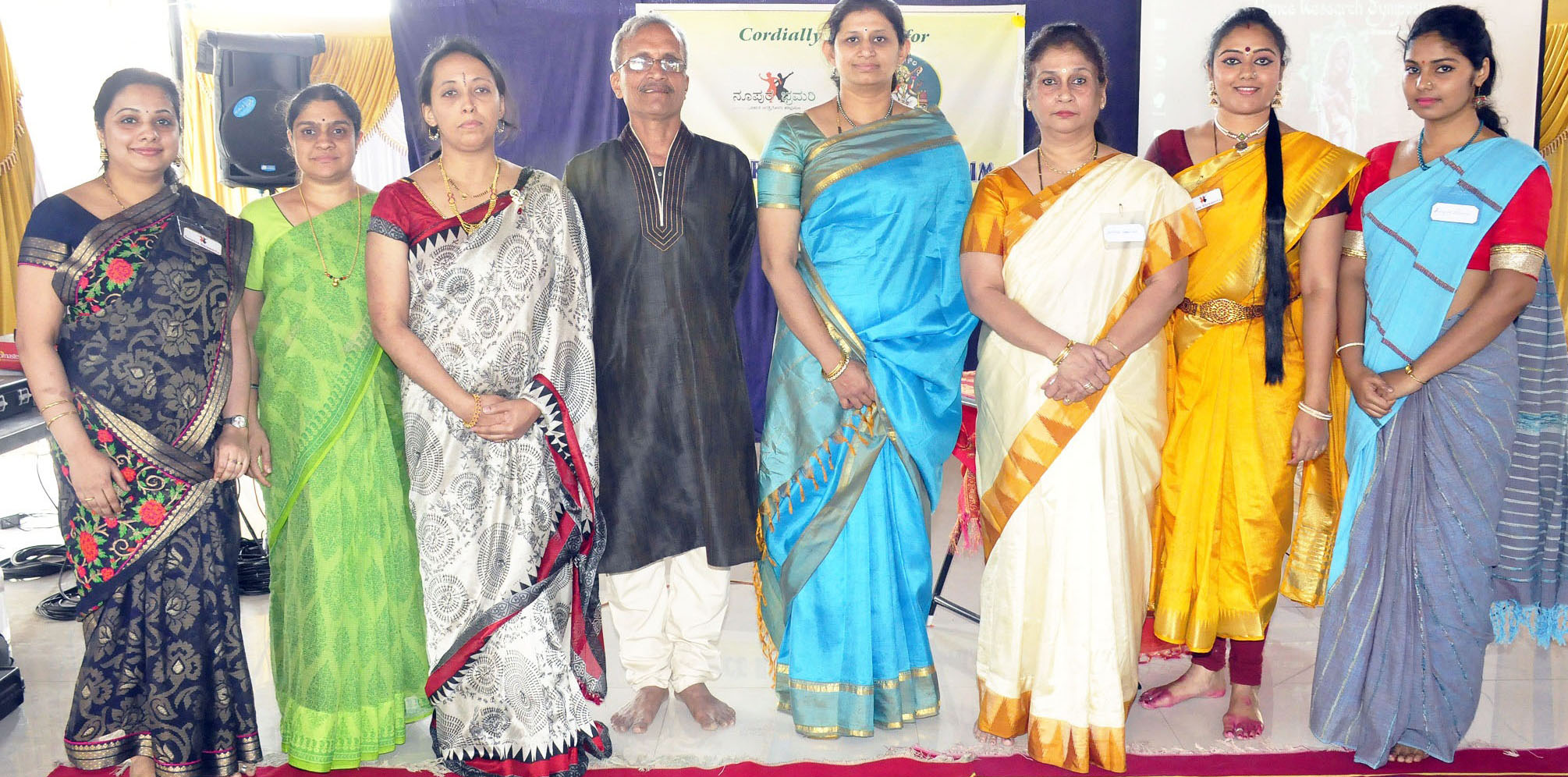
Symposium research scholars’ team
The whole session was witnessed by many students, coming from the whole state of Karnataka and many Researchers actively participated.
A special lecture by Sri. Arjun Bharadwaj (Scholar, writer, Bengaluru) was arranged on ‘Comparitive Art and Aesthetics of India and Greece. In his lecture- “Akin to the Indian Culture, the Greek culture was also closely linked to nature. Unlike the Semitic religions, in ancient Greek culture, both the creator and the creation were revered and worshiped. It is likely that the people who migrated out from the Sarasvati-Drshadvati basin in the past, are today’s Greeks and thus the close resemblance of the cultures.’ he said.

Continuing further he said “Dr. SL Bhyrappa says, that myth creation is a sign of a living tradition. The Greeks, who were at their peak in about 4th Century BC had great creative and scientific mind. They had stories associated with every place, water body and very natural phenomenon, just as we have sthaḻa-purāṇa in India even today. The death of the Greek civilization happened on the coming of the Semitic religions, which not only killed scientific thought but also all art forms. It was only with the coming of renaissance in Europe that classical art found its revival. Nāṭyaśāstra is an encyclopaedic work which not only teaches the poet and the actor but also trains a sahṛidaya to appreciate good art. There is unfortunately no parallel to it in any other culture of the world. Aristotle’s ‘Poetics’ mainly deals with dramaturgy and gives us the yardsticks to measure the worth of a piece of art. It, however, does not tell us how good art can be produced. While Catharsis is purging of emotions as a result of art, Rasānanda is the experience of bliss due to the enjoyment of art. Although there are some such differences in the two cultures, it is for certain that they share the same umbilical cord. Arjun opined that the Greek art forms can be considered a deśi form of the pan-Indian mārga laid down by Bharata” he added.
Arjun Bharadwaj’s presentation included a chronology of sculptures, paintings and mosaics from different eras of Europe. He brought out parallels between art forms and aesthetic principles of Greece and India. Arjun also explained how classical art has today taken the shape of ‘modern art’.
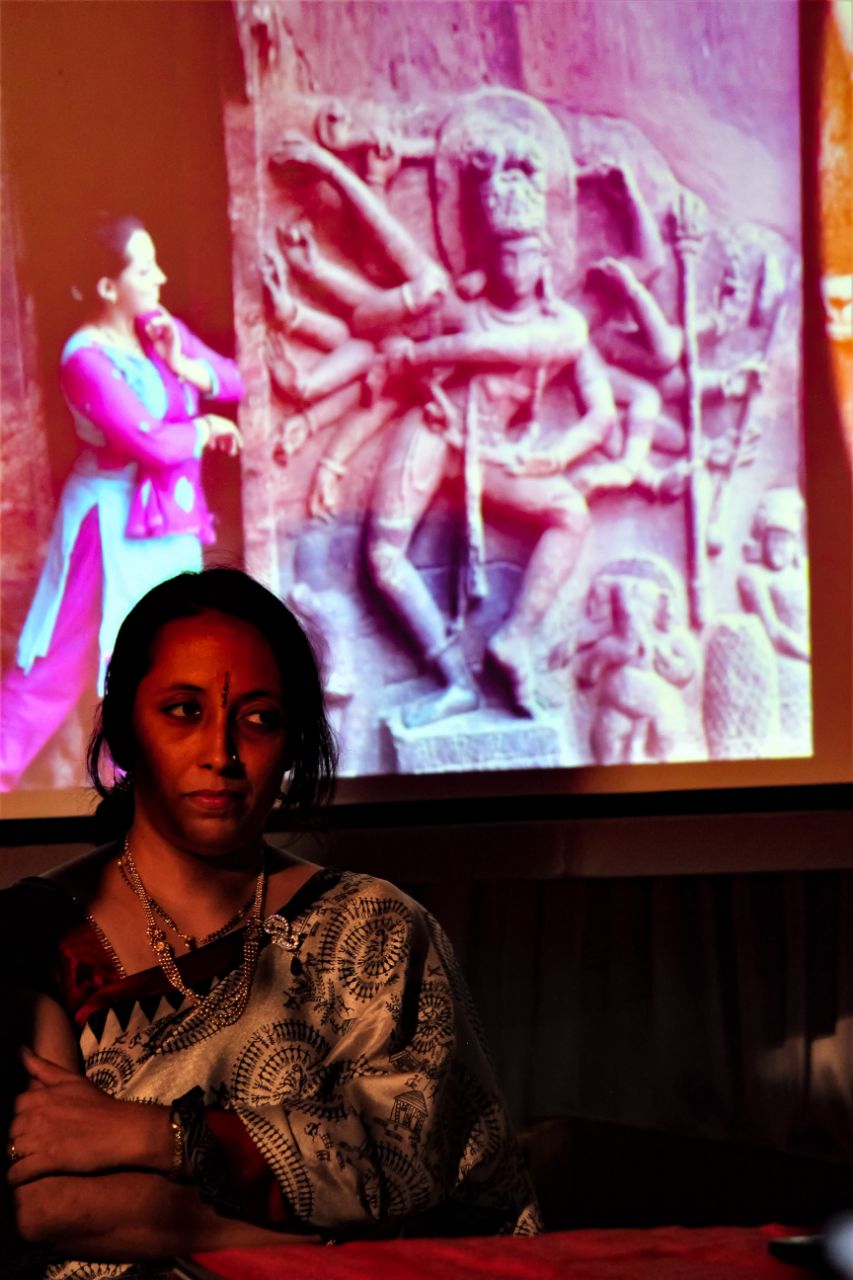
Pictures courtesy By : Pooja Balasubhramanya,
The Evening program (Valedictory session) had Chair comments for paper presentation, Release of Noopura Bhramari’s 10th Anniversary Online Research Journal issue. At the same time Sri K.N. Ananthramayya (organizer-BTM cultural academy) with the title ‘Kalayojana Koushika’ and Sri Subbukrishna (writer and organizer) with the title ‘Sahrdayi Sadratna’ was awarded with due Respects. Vid. Korgi Shankarnarayan Upadhyaya gave a scholarly speech and distributed the certificates.
Kalayojanakoushika is the title is given to the senior organizer who has involved himself in organizing continuous programmes restlessly. This type of title is not at all there in the field of Art. This has been another step of Noopura Bhramari for the first and foremost time similar to the title ‘Vimarsha Vangmayi’, which is given by identifying the best Critic. This title of Kalayojanakoushika has been accepted for the first time by the most revered organizer of many art performances Sri. K.N. Anantaramayya. He has been the most innovative organizer and very young at heart though he has crossed the age of 80 years. He has organized and has been doing it under the organization BTM Cultural Association.
After the felicitation the awardee of the title Sri. K.N. Anantaramayya said that, ‘he has been respected by many organisations, but this is something unique. The Art involves us in any programmes. When there is an opportunity, it should be noticed and utilized. Only then the doors of our lives also get opened up. Right from the inception of our organization, we have organized 525 programmes and have been successful. I am grateful to be present in all these programmes. The outcome through sincerity and discipline in the Art can be felt in our ways of Life too. Anything done for the sake of Art becomes a support and stands as our backbone.’
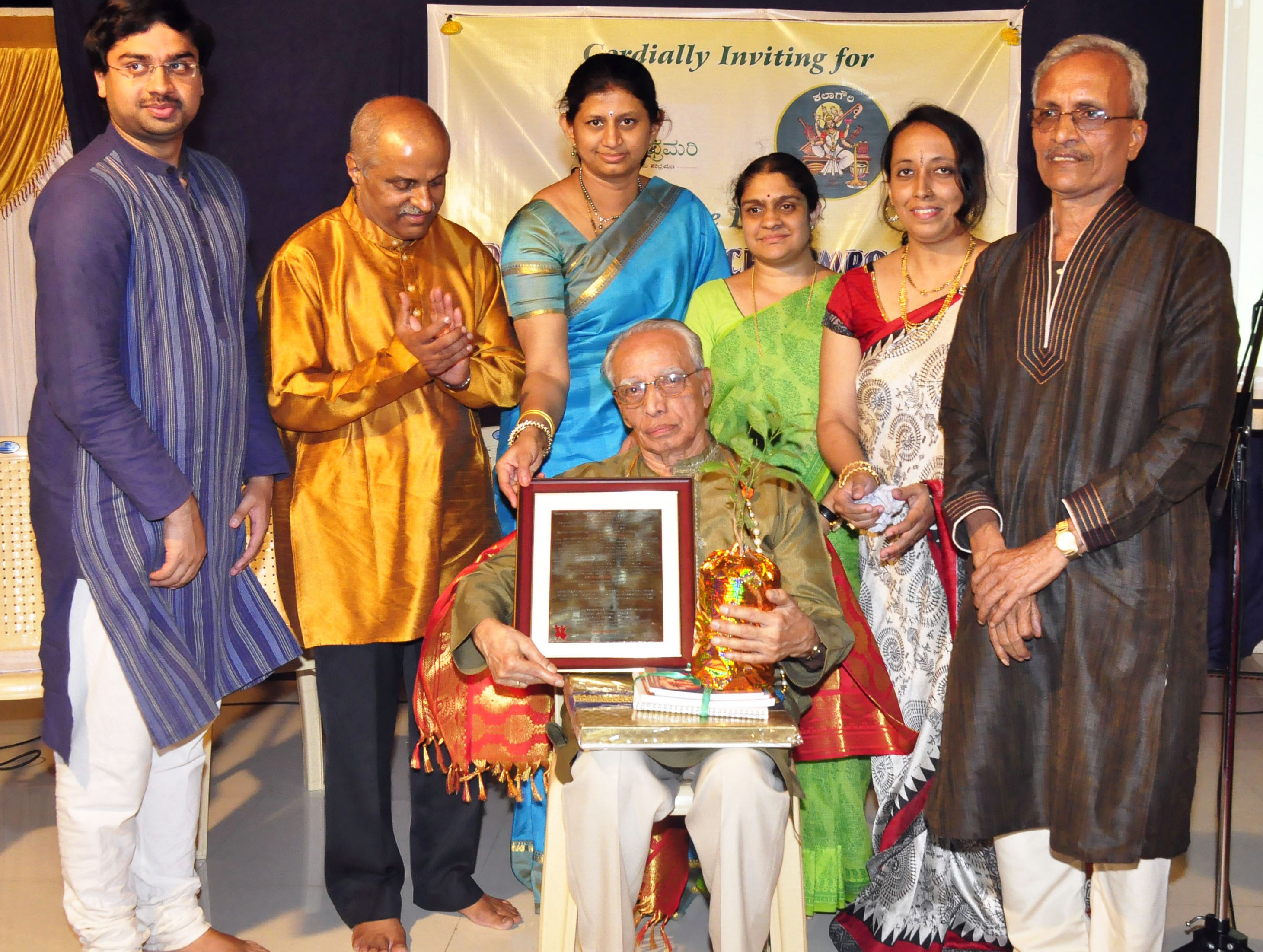
It is a common affair of Respect, Award to the artists. But identifying a good spectator and respecting them has been the first of its kind in the field of Art. Artists and also God-hearted spectators are very important for any Art. Completeness is achieved only by a talented artist in combination with an emotional sahrudayi. Thus a connoisseur was feliciatated with the title Sahrudayi Sadratna. It was awarded for the first time to Sri. Subbukrishna. He is the erson who present in almost all the art programmes. He watches the programs with an open mind, relishes, and enjoys with all his feelings and appreciates the artist openly, writes down his experiences and shares it with hundreds of people. Also, he has been organizing monthly programs in his own Krishna Kalakendra institution. The awards included Tamrapatra, Fruits, Shawl, Garland, Books and Bilwa plant.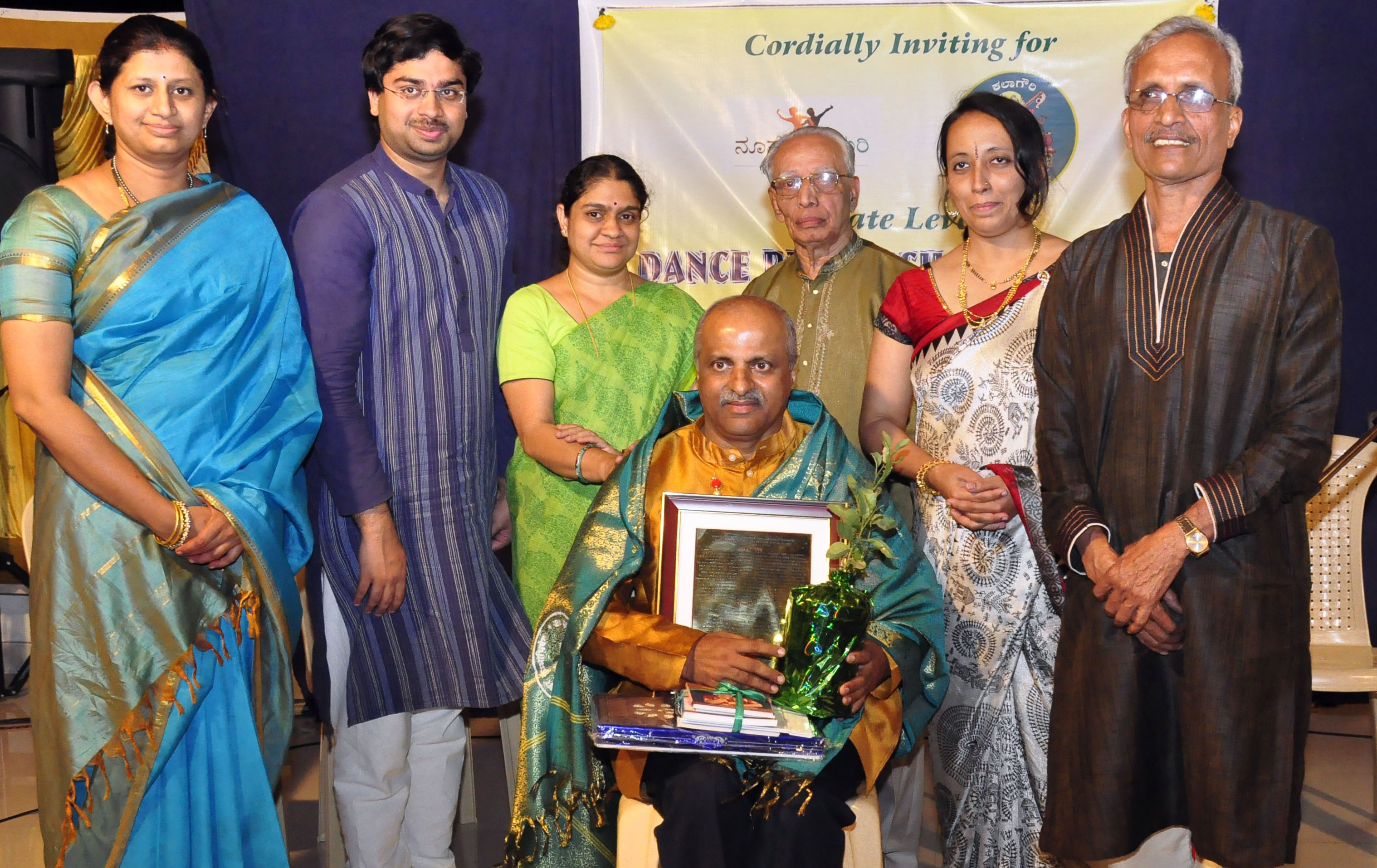
‘Vimarsha Vangmayi’, senior theatre artist, Vid. Korgi Shankarnaryana Upadhyaya, in his presidential speech spoke regarding the Research papers. He said that the Indian Art and culture is so vast that, all are understanding is limited by our own perceptions of it just like the blind understand the magnitude of an elephant by touching its parts. Hence it is difficult to fully realise the usefulness of the vision and the purpose behind this symposium at once. Newer innovations can come only when we understand the values of the past and analyze them. A new search in the field gives a good wealth of thought provoking, inspiring and innovative minds. The contribution of Noopura Bhramari to the field of Natya has been a channel for the Dance Research Symposium. The outcome of this is like that of the ‘distilled water’. Water should never get stagnant. But the flow of Art can become still only in the minds of Sahrdayas as an everlasting impact of enjoyment. This will become the pramana for rasa. The programmes organised by Noopura Bhramari have become like a ‘Highway’ in terms of rasottpatti.”

He also said that ‘there is nothing called New Research. But an individual in the journey of search gives something new which helps in sustenance. Research is a long chain. Without the basic foundation, it cannot be done. In the present scenario, where the research is being stolen, a person who has atleast respected the values of the hidden past and gives a new perspective is much better comparatively. A person should move a step further and get involved in Research in addition to collecting and documenting the information. Even while presenting, a researcher should present the ways of his understanding rather than the information provided in the books. A Dance Researcher should implement the practical adaptations which helps the audience too.”
Dance Researcher Dr. Shobha Shashikumar, Shalini. P. Vittal from ‘Kalagowri’ and the Editor of Noopura Bhramari and Researcher Dr. Manorama. B.N. were present on the stage.
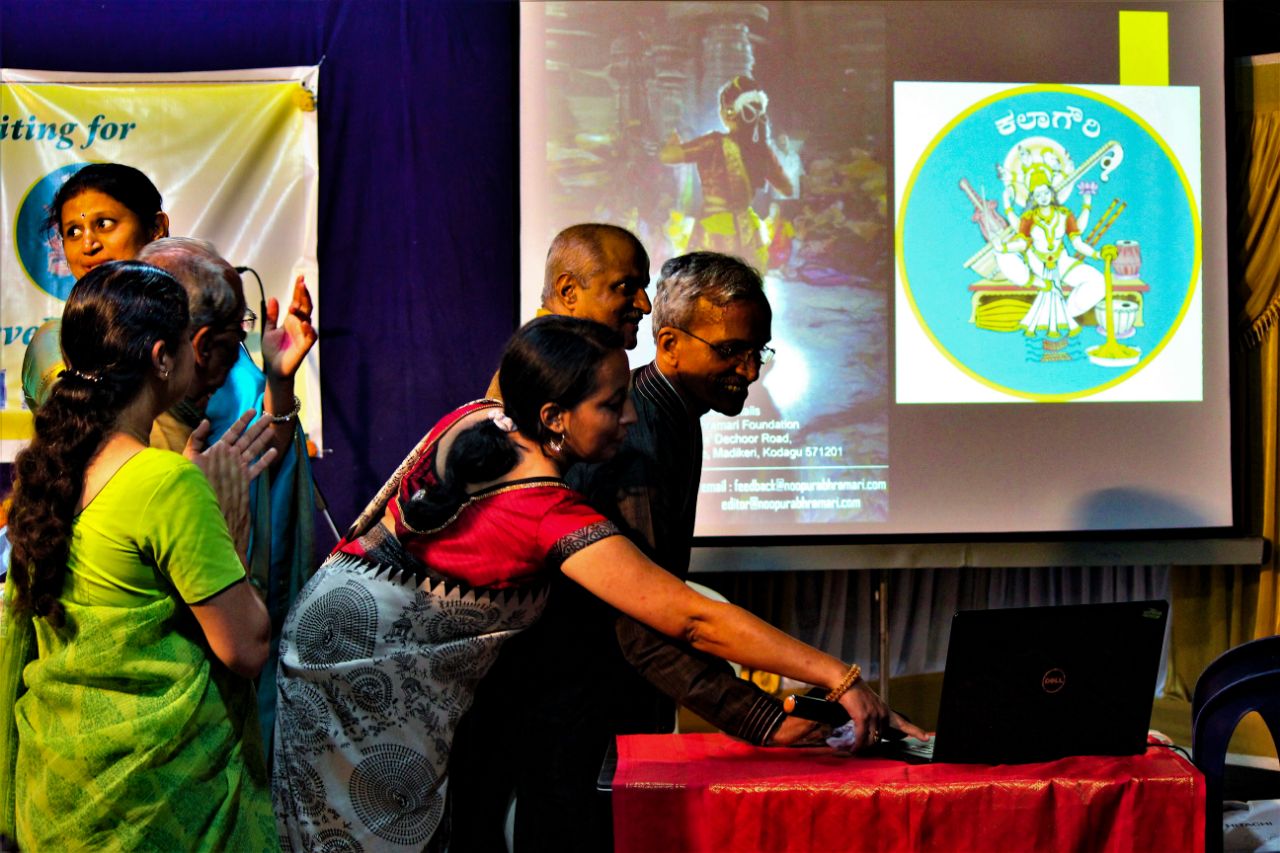
Journal Issue release
The evening session witnessed Bharatnrutya program by Smt. Megha Srinivas and Smt. Sangeeta Iyer (disciples of Smt. Dr. Shobha Shashikumar). The Badami Mahanata Koutwa, composed by Dr. Manorama and Mayura Alaripu was very well appreciated.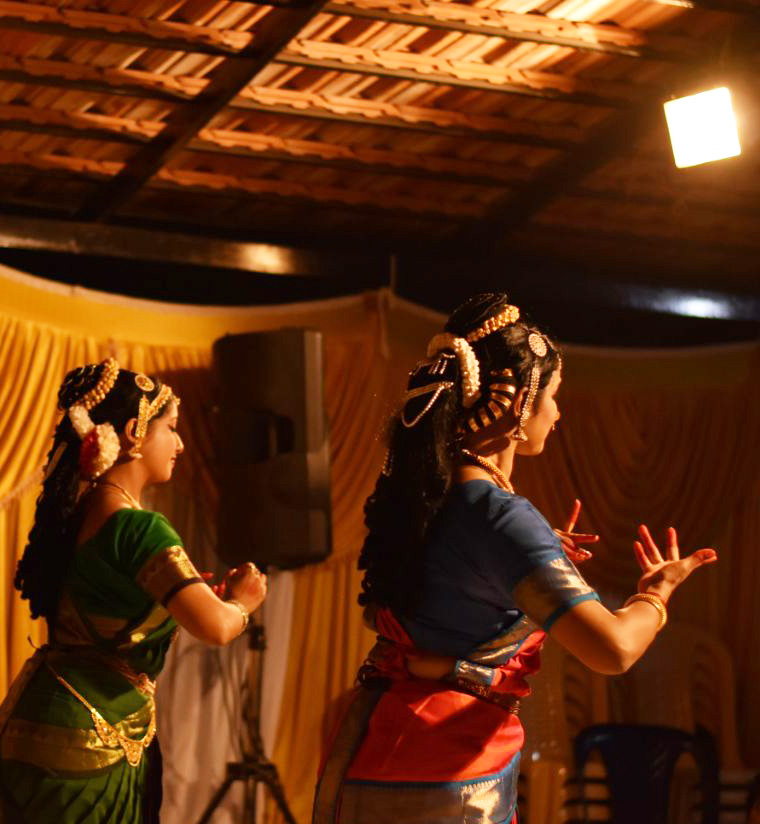
Mayura Alarippu was performed by Sangeeta Iyer as Invocatory piece.Retaining the traditional structure of an alarippu-to be performed in three levels of sama, araimandi and muzhumandi; and in three speeds- this is an experiment to utilize the Bharatanrtyam language in the alarippu format to bring out the concept of a dancing peacock. The “Mayura Alarippu” as such is not a new concept. In fact, the dancer was inspired to create this piece after having watched one such rendition- she felt that the Mayura could be justified in angika by the use of Bharatanrtyam.
Traditionally, an alarippu is interpreted as the blooming of a flower- where the dancer is the flower, and she blooms to perform the rest of the margam. Sangeeta interpreted it as a peacock, which get inspired by clouds and dance in its own way. She has brought various karana into alarippu and this piece as the unfurling of the peacock for the rest of her recital. The vakyarthabhinaya which she incorporated in the angika of Alarippu nrita itself has made alarippu to reach its best of communication. It has taken wide applause too. It was set to Rupaka talam (Tisra Alarippu). It is available in https://youtu.be/A5Slp4PVvuo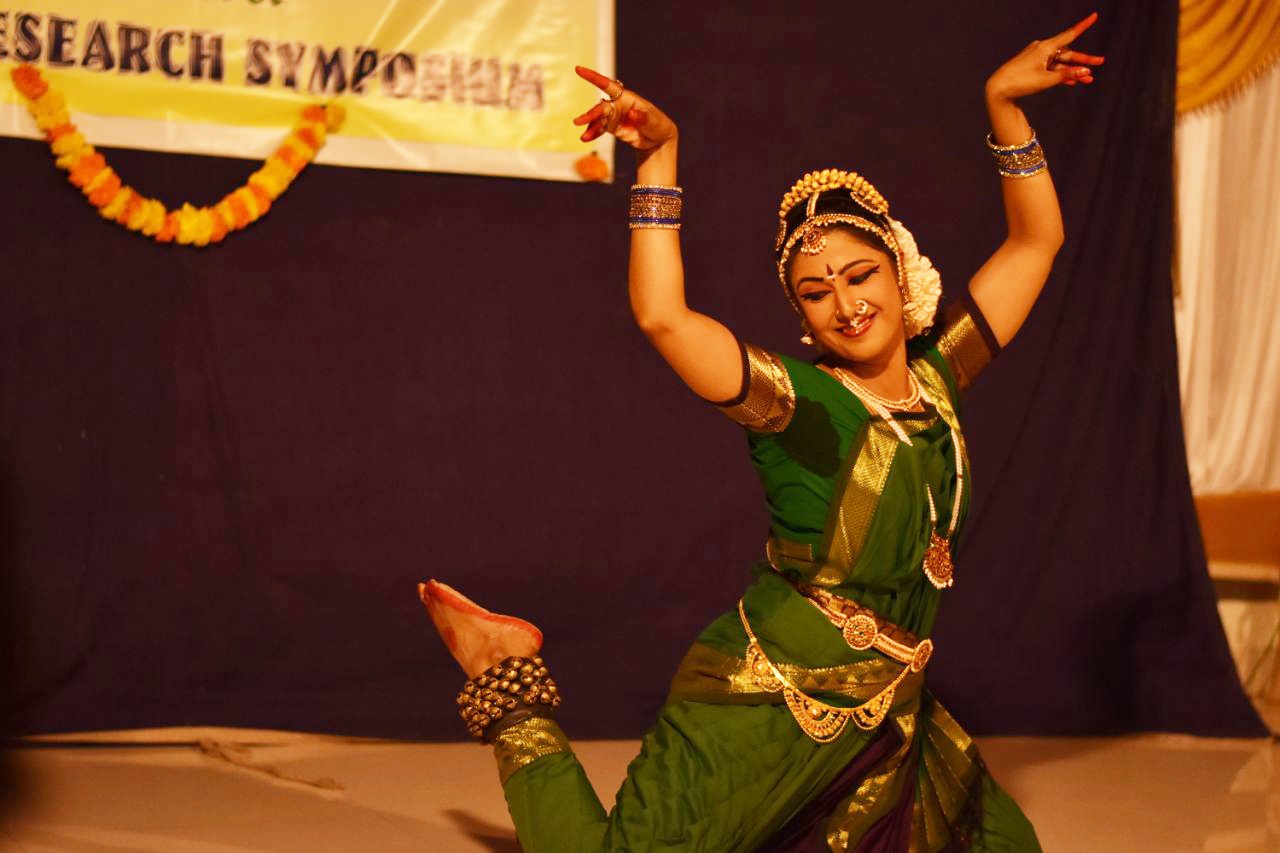
The next piece was by Megha Shrinivas. She taken the concept on Mahanata Kouthvam (based on the Mahanata-shiva sculpture of Badami, Karnataka) composed by Dr. Manorama B.N. in Ragamalika and set to Khandachapu tala. Here the sutradhara visualized Mahanata as the one trying to please his dear consort Parvathi, who is upset that her Shiva is dancing along with Ganga. Shiva becomes the Mahanata and performs the karanas because he knows that dancing is easiest way to calm his Parvathi and pacify her. He performs Apaviddham, Nikuttkam, Rechitanikkuttitam, Akshptam, Sarpitam, Mattalii, Ardha matalli, Valitam, Lalitam, Dolapada, Bhujanagatrastarechitam, Bhujangatrasitam for Goddess Parvathi.
Parvathi laughs and thinks to herself that she is already within him and that she needs no convincing about his love for her and begins to dance along with him. She performs Avartam, Prushtaswastikam, Vakshasvastikam, Ardhasvastikam, upasrtakam along with Shiva. The sutradhara perceives Shiva and Shakti as ‘one’ and explains how both the energies are manifested in the same body and how they stand together as Ardhanaarishwara. Ganesha, who watches the beautiful dance of Shiva and Parvathi comes in between to show off his dancing skills and performs Karihasta.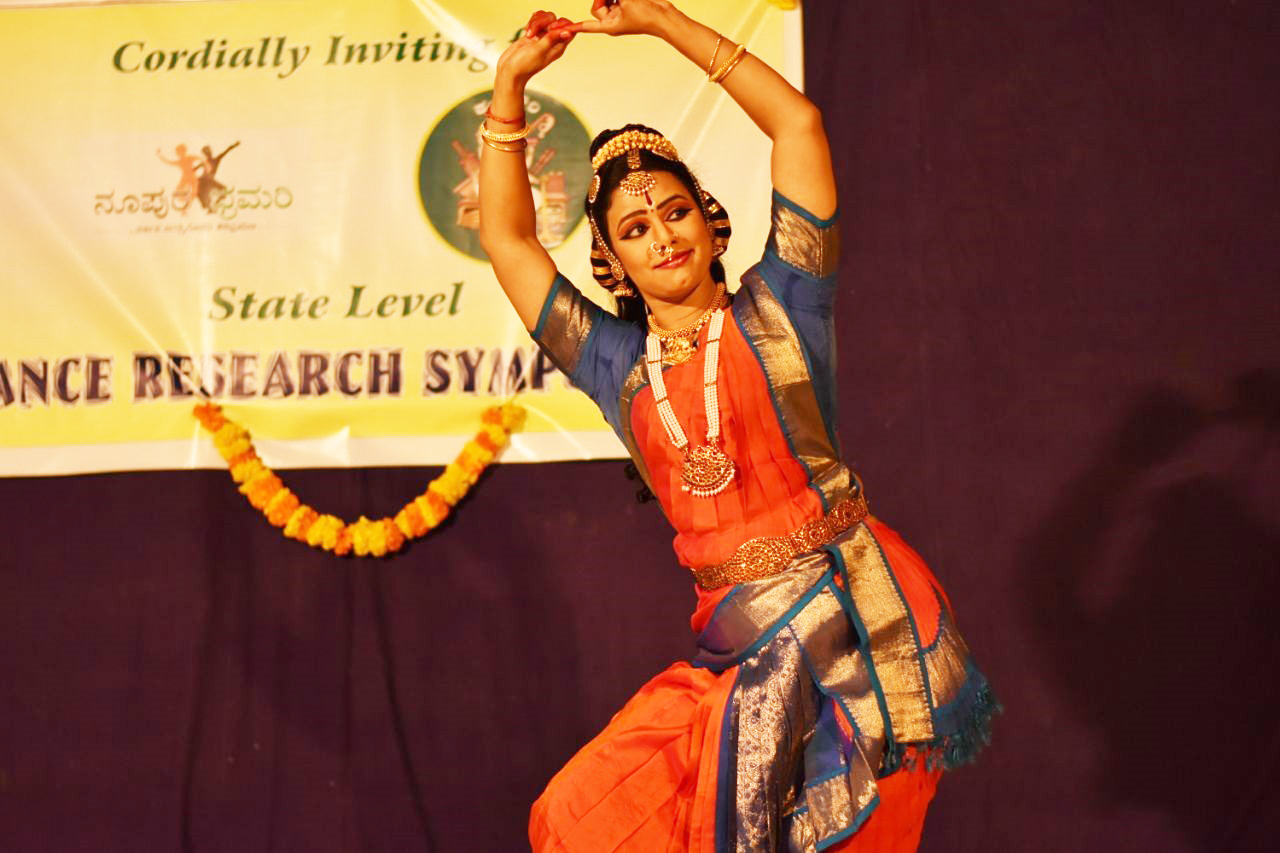
In concluding lyrical treatment, Sutradhara says that this Mahanata who shows himself in the human form is the greatest of the dancers and that his dance is a Veda for the dancers today. Sutradhara goes on to say that just one glance from this Great Mahanata would bring him all the happiness and contentment. These all elements were beautifully portrayed by Megha. It is available in https://youtu.be/kc0OdrBTxSM
‘Aartha Piravi Tuyarkeda’ composition of Manickavasagar was the next selection by Sangeeta Iyer. This song taken by Tiruvempavai which is based on in the Tiruvannamalai temple. Pavai means young girl, or maiden. In the month of December- January, young girls observe a penance or vow, called Pavai Nombu, during which they visit the Annamalai temple every day of the month, bathe in the temple tank and offer prayers to Siva. In doing so, they believe that He will bless them with a good husband. The situational context was Manickavasagar’s Tiruvempavai hymns is the temple tank. All songs are composed as if being sung by these young girls while bathing in the tank before prayer. Manickavasagar was a 9th century Tamizh Saivite saint poet- who along with Appar, Sundarar, and Sambandar- is one of the Nalvars, or the four most important Saivite saints of the Bhakti period. Their compositions, together, called the Tirumurai, form the foundations of Tamizh Saivite philosophy.
 The 12th song, which was presented by Sangeeta, spoken of the attributes of Siva as the cosmic dancer Nataraja in Chidambaram. He is the Divine Dancer in the Chit- Ambaram (or stage of consciousness), who dances with the Teertha (Ganga). He is the earth, He is the sky, and He is everything. He creates, protects and dissolves- this is His game. “Thus, singing of His praises, and thinking of His great attributes, let us bathe in this tank, my dear girls.” Their bangles are jingling, their hair is swaying, and their ornaments hiss, as they bathe in the Poigai river, which has beautiful flowers all over it surrounded by buzzing bees. The girls fix their mind on Siva, and sing only His praise. Performance was set to Shankarabharanam raga and Aditala.
The 12th song, which was presented by Sangeeta, spoken of the attributes of Siva as the cosmic dancer Nataraja in Chidambaram. He is the Divine Dancer in the Chit- Ambaram (or stage of consciousness), who dances with the Teertha (Ganga). He is the earth, He is the sky, and He is everything. He creates, protects and dissolves- this is His game. “Thus, singing of His praises, and thinking of His great attributes, let us bathe in this tank, my dear girls.” Their bangles are jingling, their hair is swaying, and their ornaments hiss, as they bathe in the Poigai river, which has beautiful flowers all over it surrounded by buzzing bees. The girls fix their mind on Siva, and sing only His praise. Performance was set to Shankarabharanam raga and Aditala.
Later Megha performed kriti on goddess Lakshmi composed by Vid. R. K. Padmanabha, set to Nayaki raga and Khandachapu Tala.This kriti described the beauty of Goddess Lakshmi who is called ‘Soumya nayaki’ because of her grace and elegance and charming beauty which equals not 1 or 2 but a hundred Urvashis. The dancer requested beautiful goddess Lakshmi to bestow upon her grace and humility.
Sangeeta later taken the the first song of Tyagaraja’s Nauka Charitram- Srngarinchukoni Vedaliri. As many of us know, Nauka Charitram is a musical ballet (geya nataka) composed by Tyagaraja- having padyas, vachanas and dharus. The story is of Krsna’s meeting with the gopikas at Yamuna- He meets them by the river side and takes them all on a boat ride on the scenic Yamuna river. As the story unfurls, we see how the pride and ego of the gopikas is removed by Krishna and his leelas. Srngarinchukoni is the first dharu of Nauka Charitram- which describes the ways in which the gopikas are getting ready to go meet Krishna. Each one is dressing up, and preparing in a different way to entice him. It was set to Surutti ragam and Aditalam.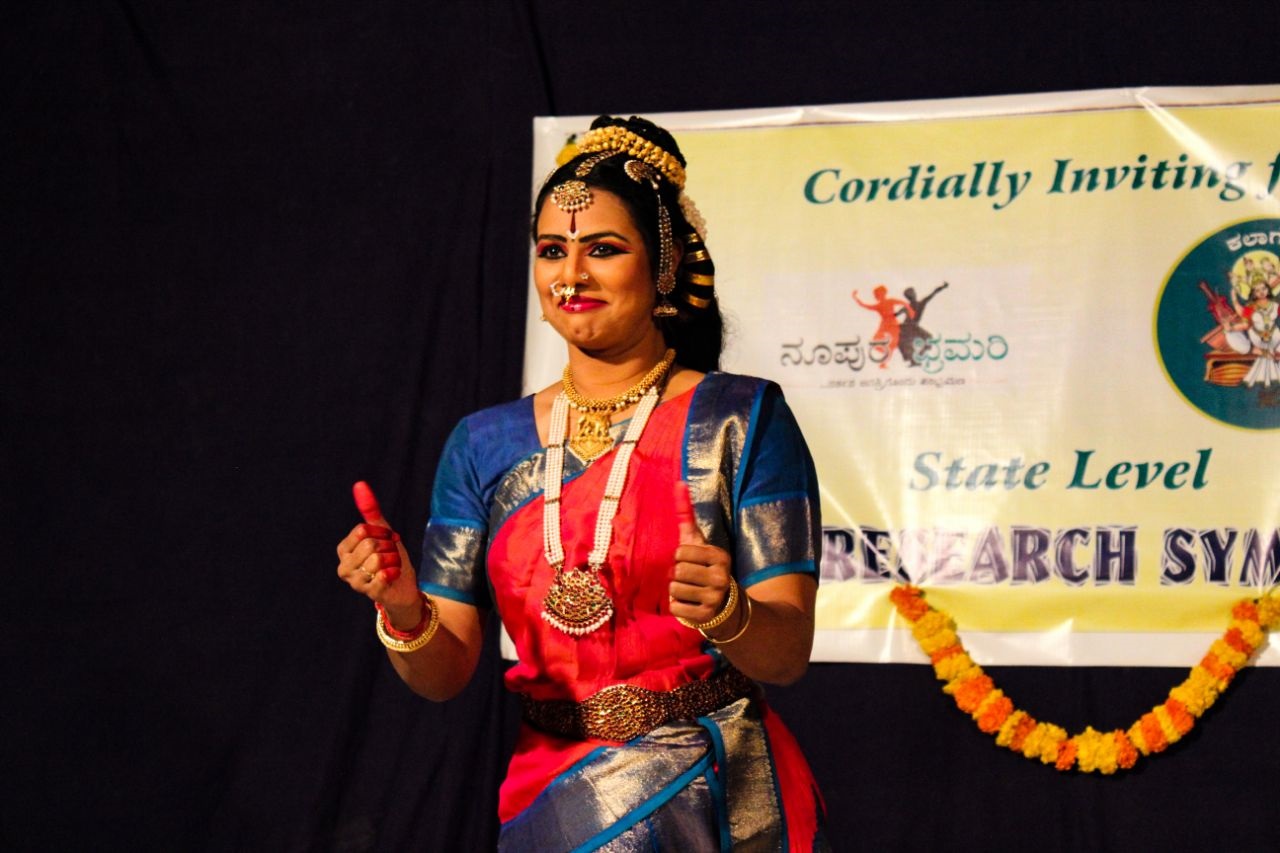
Antahpurageethe composed by D. V. Gundappa set to Behag raga and adi tala was concluding piece performed by Megha Shrinivas. Here the sakhi finds her very good friend talking to a parrot and goes on to enquire what message she is sending with the parrot and to whom. She teases her friend that she has been hearing a lot of gossip about her from people and if it was all true. She also asks her why she is abusing few women and appreciating few other and what secrets of manmatha she is telling the parrot.
The sakhi asks Shukabhaashini to share both the matters that she is upset with and also those that make her happy. She goes to tell her to stop sending messages alone to her lord and instead meet him as he is very upset of not having met her. She questions Shukabhaashini if she could find no messenger other than the parrot to communicate about her love for lord Channakeshava. She complains that Shukabhaashini has neglected her very good friend and instead has had the parrot as her dhooti. Sakhi requests if she could be appointed as the messenger instead of the parrot as she would do a better job than the parrot.
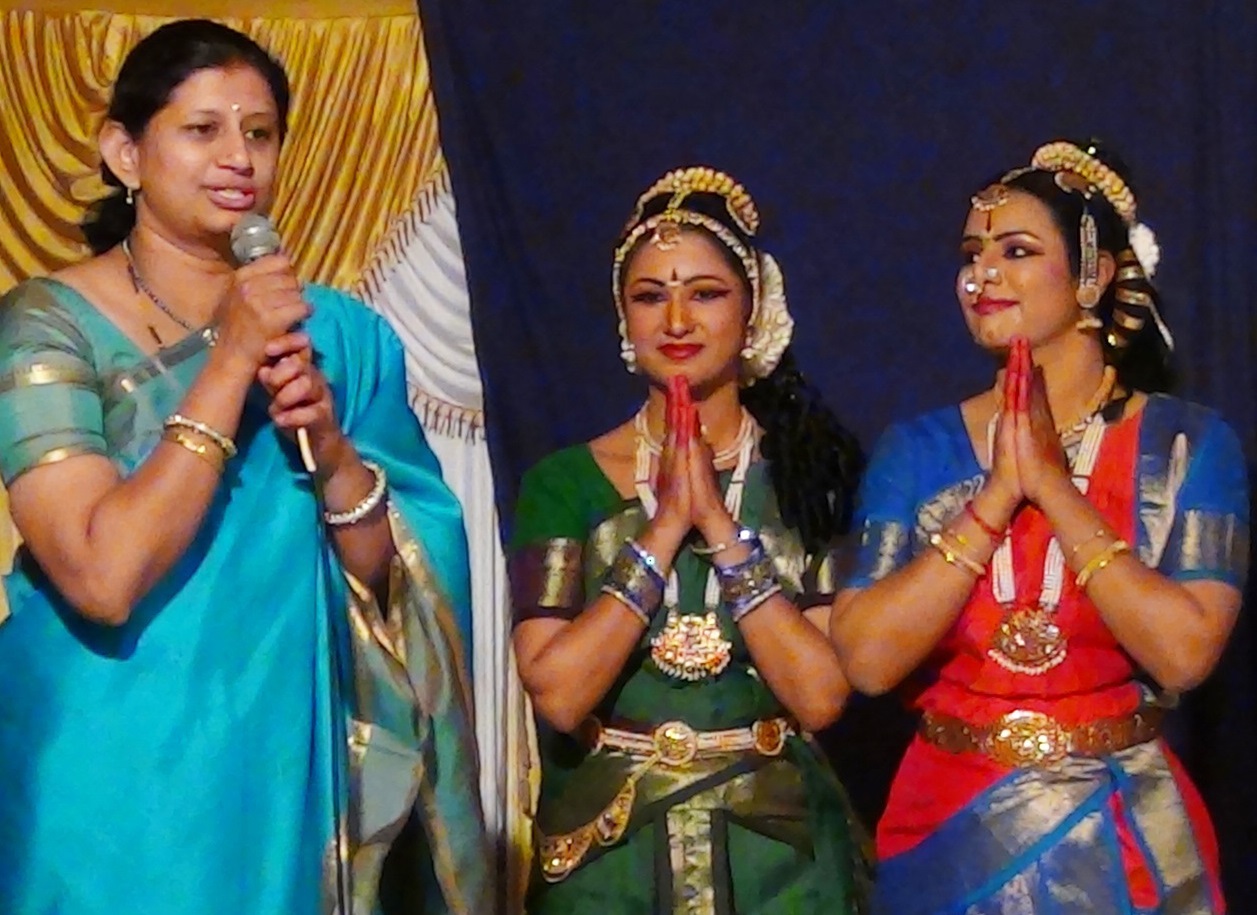
In Vocals Kum Priyankaari Krishnan and Varsha R Krishna, in Nattuvangam: Smt. Madhulika Srivatsa, in Mrdangam Sri Betta venkatesh, and in flute Sri Skanda Kumar supported and brought a good feel.
The whole symposium was happened to be like ‘Natya Jagara’- offering to Lord Shiva through a dhyana on Natya, in its own kind by bringing an integrated approach.